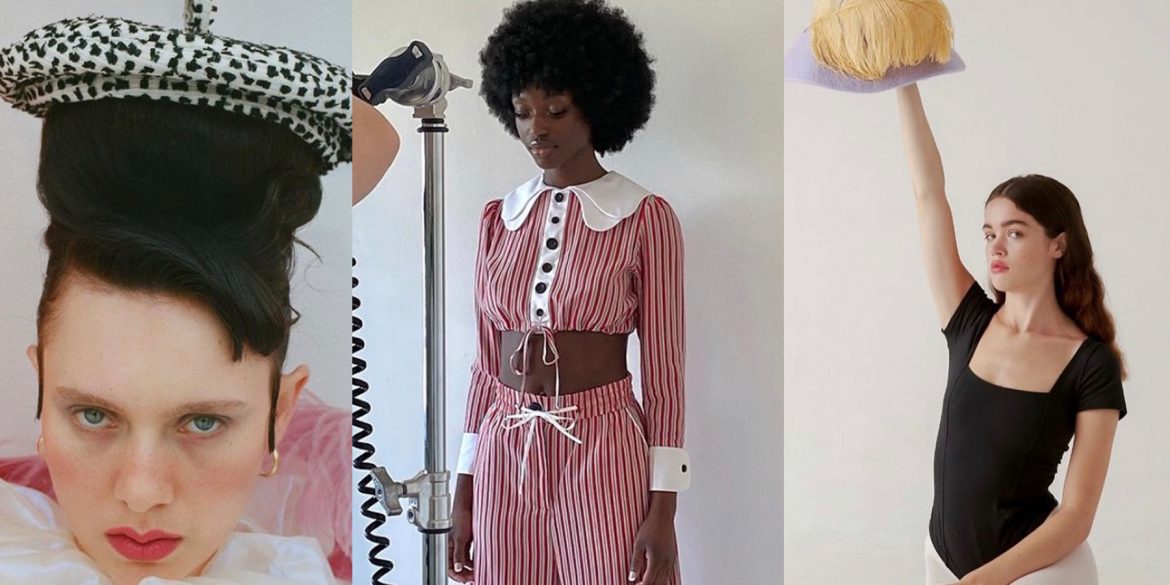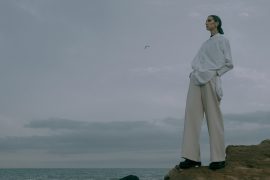[dropcap letter=”O”]livia Latinovich grew up in Indiana with the heart and drive to be creative. Growing up surrounded by creatives, she quickly came into her own with her love for clothing and self-expression. First starting out in the corporate sector, she quickly realized that wasn’t for her and devised a new plan – launching her own fashion brand. PATTERN had the chance to speak with Latinovich about all things style, sustainability, and surviving and thriving through a pandemic.
Allie Coppedge: You grew up in Indiana, what was that like for you and what inspired you to get into fashion design growing up?
Olivia Latinovich: It’s really funny because I’m standing in my childhood bedroom and all of the books are Audrey Hepburn and Givenchy. I used to be late to school when I was in second grade, because I didn’t like my outfit. It’s been something I’ve been interested in since I can remember, it’s been in me since I was able to start dressing myself. It probably has a lot to do with the fact that I was a bit more shy when I was little. Dressing was a way to express myself without having to say anything. Growing up in Indiana, I had a lot of creative women in my life. My grandma taught me how to sew, my mom always dressed in her own style and my other grandma was an amazing interior decorator. One side was visual and one side was very tactful and taught me how to piece things together. The women in my life put those seeds there and it grew into something organically.

AC: How did you make the decision to go to the Savannah College of Art and Design (SCAD)?
OL: That was a really tough decision to make as an 18 year old, to say I’m going to be a fashion designer. It felt lofty even when I was saying it as a young person and it was the first time I was leaving home. Overall what sold me is that SCAD has really amazing opportunities for their students; they are a very connected and well rounded program. I knew I wanted to be a part of their fashion show. I was attracted to the allure of an art school, it both scared me and drew me in. It was touch and go there for the whole first year. I was this small town Indiana girl and for the first time exposed to the art school vibe where many of the kids had gone to high schools with amazing art programs. My high school art teacher told me I had potential and that I needed to keep going forward. Her name is Ms. Fritz and she ran the AP art program which was hard to get into. I really wanted to be in it, but instead she told me to go back to Drawing 1 as a junior, saying I needed to learn the basics and refine my skills. She was right to tell me that.
AC: After you graduated from SCAD, you went to New York to design. Then from New York, you went to France. So you were moving around a bit, can you speak on that?
OL: I was in New York and it was really fun. I was in a spot though, creatively, working for a big brand where I wasn’t able to be creative enough. It felt like I was just sending emails for a living. I didn’t quite feel like I was seen. Eventually I thought, this has been great, but I want to find a way that I can use the skills I learned at SCAD where I was truly creating. I missed that feeling of being intimate with my own work. I realized I really do thrive on that, so I applied for an atelier, it’s a program through SCAD where you basically pitch them your idea for a business and if you’re selected you get a small grant and you go to France and work on your idea in an atelier in a little village there. I ended up finding out I got it and had to quickly get out of New York to go there. I’d studied abroad in France before so I knew a little bit of French. I spent time there focusing on the brand, crafting the brand identity, and the elements that make up the brand. I was still playing pretend in a way, like I wasn’t sure if fashion design was something I’d do for a living. Then I thought, you’ve already come this far you may as well go for it.

AC: That was a short term thing then, you knew you’d be coming back to the States after that. How did you decide on LA?
OL: It’s not a story without a little bit of boy drama. I’d dated the same guy all throughout high school, but I had chosen art school and he was staying to go to State school so we went our separate ways. Then five years later I asked him to be my plus one to a wedding and fast forward to now and he’s my husband. He was living in San Francisco at that time, but he came with me to France and was my right hand man the whole time, helping define things from the business perspective. We decided in France that we had started building a life together so we landed on LA as a compromise.
AC: What was the first item that you created for the brand.
OL: The first item was a Biba hat. I started out by only doing hats because the project that I pitched to get the grant was a French hat shop so I was making a bunch of them.
AC: I noticed that you’ve expanded into clothing as well. How did that happen?
OL: I’ve always wanted to take it into clothing, I just didn’t realize how soon I was going to be ready to build out the story more, therefore the product range more. I also just love clothes and collect vintage, so it happened naturally.

AC: Yeah definitely, and I feel like your brand really has a cohesive image. So going from there, how has your fashion style evolved throughout the years?
OL: SCAD’s fashion program does a good job at telling you the sky’s the limit, make it as conceptual as possible, build a crazy world. I did my collection on Pippi Longstocking. If she were alive today or had a show, what kind of things would she be wearing. Something about her attitude I needed personally, to make that collection happen, so I built the concept around her and used her ideas to help me get through sewing this crazy collection on my bedroom floor. The way that it’s changed is that I’ve become a little bit more practical. I would say that comfort is a thing that I wouldn’t have cared about, I used to wear six inch platforms everyday and march down the street to meetings. I didn’t even own a winter coat in New York. It was all about the look. Now I would say I’m more practical and a bit more refined as I’ve gotten older. Less all pink, all yellow, starburst pallet. More refined and chic, using textures in an elevated way. I probably wouldn’t have understood that in college, I was just packing a punch.
AC: Nice, I like that. I also noticed that everything is made in LA and you tried to make it as sustainable and ethical in the production as you can. I assume that is important to the brand?
OL: It is. It was really important to us to have those kinds of practices, having a sustainable manufacturer and using deadstock fabrics. It was important to know how to do that before we started making these full blown collections. As a newer brand, it’s also much easier to start there and having good ethics be the groundwork. Then expand into creative ways to input sustainability into your brand more and more. Now, I don’t even think of it. It’s the humane thing to do and it’s normal now. That’s our standard and we’re going to keep doing better and better at it.

AC: The pandemic has been especially hard on small businesses, so how have you had to adapt to that?
OL: The collection that is currently on our website, the only ready to wear collection we’ve done thus far, I actually designed about two years ago. I was trying to find a manufacturer in LA and make it work, then the pandemic happened. No one could produce it and I didn’t want to forfeit those sustainable and ethical values we just talked about. It delayed me having any product to sell for months. Eventually I ended up getting connected to this amazing factory whose values aligned with ours and they were able to produce my collection, just in very limited runs because of the reduced capacity they were functioning at. It was a really stressful time because I was so proud of the collection and the later it got pushed back, it felt like it was losing its relevance. I just had to roll with the punches. It felt like we went through the worst thing imaginable so now going forward, it feels like everything will be easy.
AC: So on that note, what’s next for the brand?
OL: We changed our business model a little bit, so we’ll be dropping product at the beginning of each month instead of doing a big drop every four months. Starting in February we have the drops organized throughout the year. It will just be more fun and keep things fresh.
You can shop Olivia Latinovich online, and follow her on Instagram. Be on the lookout for the new collection dropping in February!



